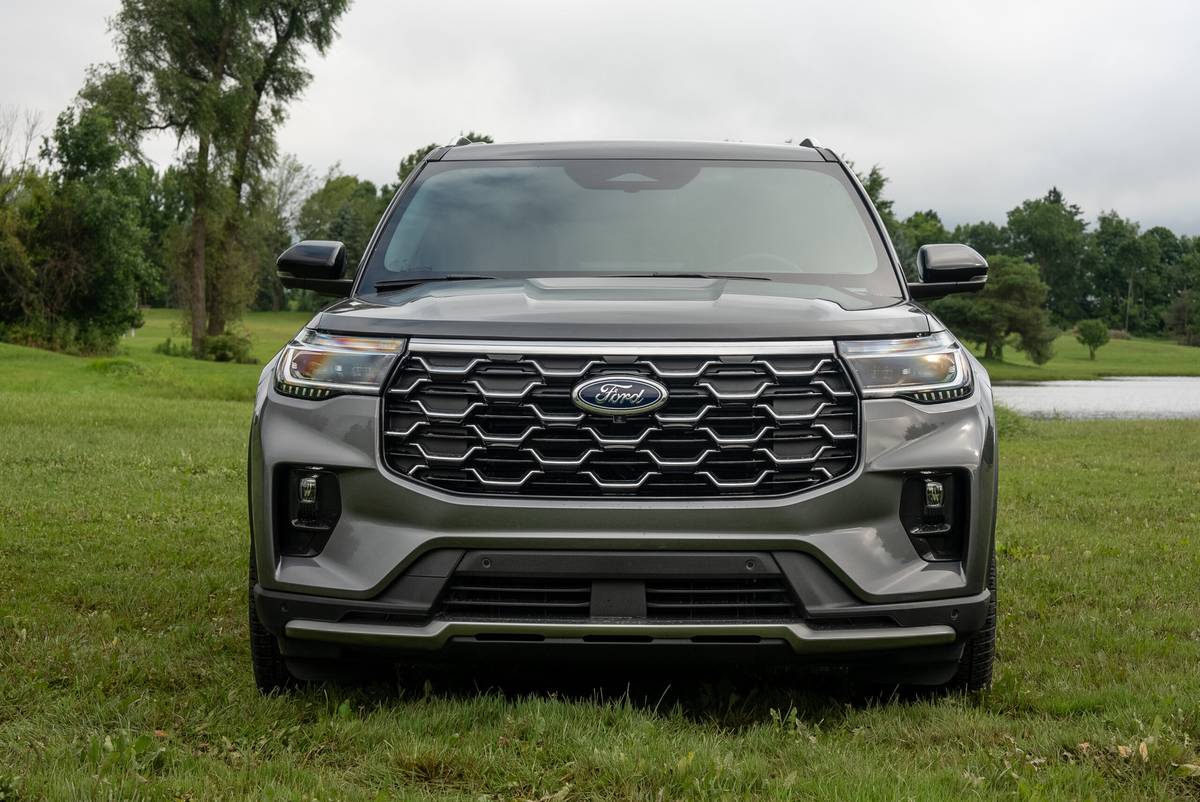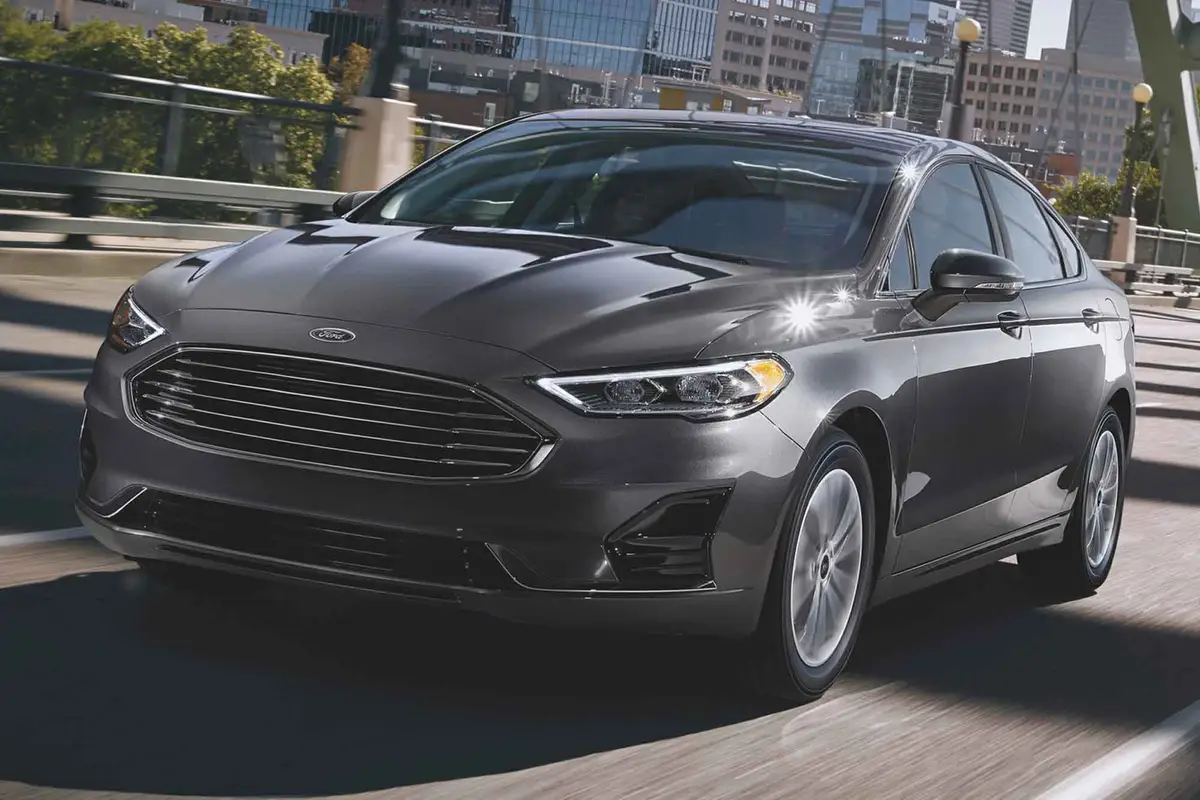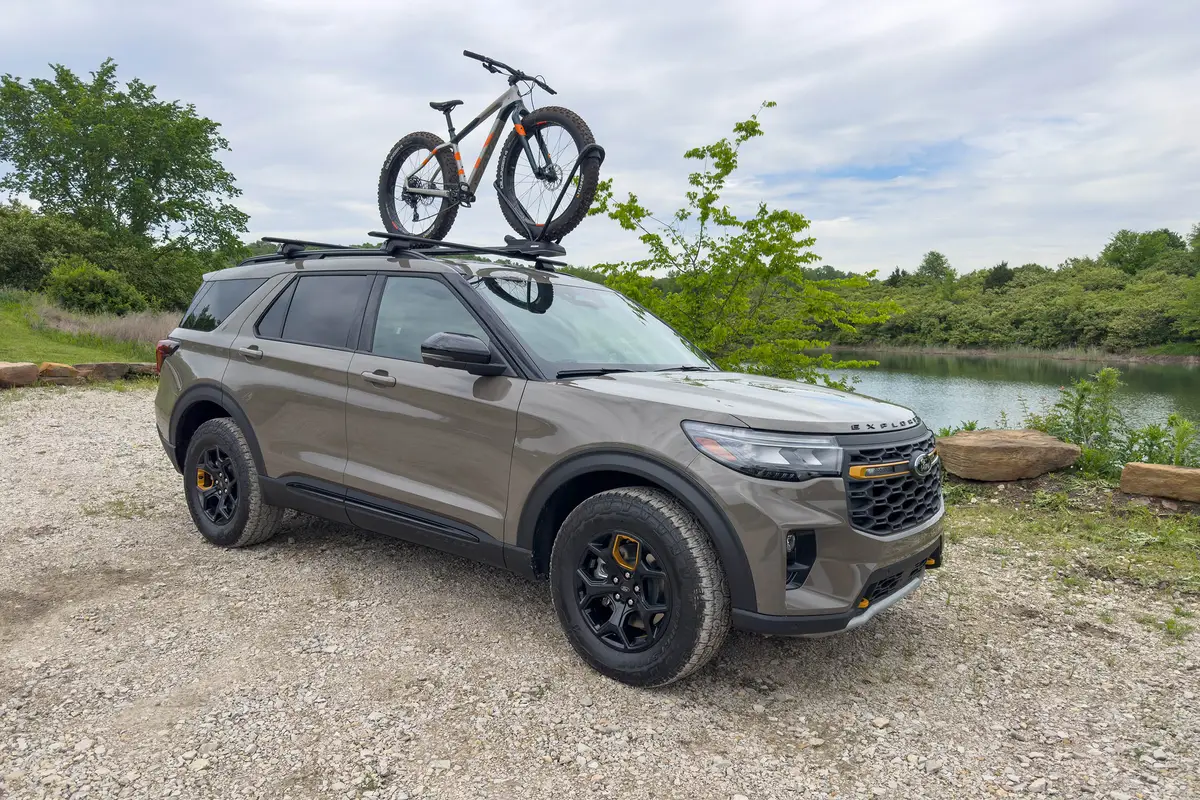Ford Explorer
The content on this page was created using generative artificial intelligence powered only by Cars.com articles and edited by Cars.com’s Editorial team for accuracy.
The Ford Explorer wasn’t the first sport utility vehicle, but it hit on the right formula to become the bestselling SUV and help fuel the popularity of the class. Starting as a truck-based SUV, the Explorer continually added carlike features and refined ride quality. In the early 2000s, sales took a hit thanks to increased competition and Firestone tire failures, but they’ve been improving with the popularity of recent versions. The Explorer was redesigned for the 2020 model year, and the sixth generation marks a return to the SUV’s rear-wheel-drive-based roots. Other previous variations included the Explorer Sport Trac, which had a pickup bed, and the Explorer Sport, a name used on early two-door versions as well as a later performance offering. The Explorer’s architecture was also used for the Mazda Navajo, Mercury Mountaineer and Lincoln Aviator.
2020-2026 Explorer
With its 2020 redesign the Explorer returned once again to a rear-wheel-drive-based platform. Its styling is similar to the previous generation, though the SUV is a bit bigger and has a longer wheelbase that helps create more cargo room. Power comes from a standard

2026
- MSRP range
- $38,330–$56,770
- Consumer rating
-
- Combined mpg
- 20–24
- Body style
- SUV
2025
















































































































- MSRP range
- $40,050–$56,770
- Consumer rating
-
(6 reviews) - Combined mpg
- 20–24
- Body style
- SUV
- Refreshed styling and tech for 2025
- Three-row, six- or seven-seat mid-size SUV
- Standard RWD, optional AWD (all trims)
- 300-hp, turbocharged four-cylinder or 400-hp, twin-turbo V-6
- New Google-based Ford Digital Experience multimedia system
- Now available with BlueCruise hands-free cruise control (subscription required)
2024














































































































































































































































































































































































































- MSRP range
- $36,860–$56,770
- Consumer rating
-
- Combined mpg
- 20–24
- Body style
- SUV
- Hybrid drivetrain discontinued
- Three-row SUV
- Rear- or four-wheel drive
- Choice of two turbocharged gas engines
- Performance-focused ST and off-road-oriented Timberline trim levels
2023


































































































































































































































































































































































































































- MSRP range
- $36,760–$56,525
- Consumer rating
-
(8 reviews) - Combined mpg
- 20–26
- Body style
- SUV
- Three-row SUV
- Rear- or four-wheel drive
- Choice of two turbocharged gas engines
- Hybrid drivetrain available
- Performance-focused ST and off-road-oriented Timberline trim levels
2022






























































































































































































































































































































































































































































































- MSRP range
- $35,510–$55,630
- Consumer rating
-
(19 reviews) - Combined mpg
- 20–26
- Body style
- SUV
- New ST-Line trim level
- Three-row SUV
- Rear- or four-wheel drive
- Choice of two turbocharged gas engines
- Hybrid drivetrain available
- Automatic emergency braking standard
2021




































































































































































































































































































































































































































- MSRP range
- $32,925–$54,600
- Consumer rating
-
(76 reviews) - Combined mpg
- 20–25
- Body style
- SUV
- New Timberline, King Ranch trims
- Three-row SUV
- Rear- or four-wheel drive
- Choice of two turbocharged gas engines
- Hybrid drivetrain available
- Automatic emergency braking standard
2020














































































































































































































































































































- MSRP range
- $32,765–$58,250
- Consumer rating
-
(263 reviews) - Combined mpg
- 20–24
- Body style
- SUV
- Redesigned for 2020
- New rear-wheel-drive platform
- Four-wheel drive available
- Two turbocharged gas engines
- 10-speed automatic transmission
- Hybrid and high-performance ST models offered
2011-2019 Explorer
In a major change, Ford moved the Explorer from a truck-based, rear-wheel-drive body-on-frame platform to a car-based, unitized front-wheel-drive platform. Though still marketed as an SUV, it was now more accurately a crossover. The largest engine was a V-6, while turbocharged four-cylinders

2019






















































































































































































































































































































- MSRP range
- $32,365–$54,165
- Consumer rating
-
(114 reviews) - Combined mpg
- 18–22
- Body style
- SUV
- Seats up to seven in three rows
- V-6 engine standard
- Turbo four-cylinder and turbo V-6 available
- Front- or four-wheel drive
- Apple CarPlay, Android Auto connectivity available
- Hands-free power liftgate available
2018








































































































































































































- MSRP range
- $32,140–$53,940
- Consumer rating
-
(268 reviews) - Combined mpg
- 18–22
- Body style
- SUV
2017




























































































































































































































- MSRP range
- $31,660–$53,235
- Consumer rating
-
(373 reviews) - Combined mpg
- 18–22
- Body style
- SUV
- New Sport Appearance Package
- Seats up to seven in three rows
- V-6 engine standard
- Turbo four-cylinder and turbo V-6 available
- Front- or all-wheel drive
- Hands-free liftgate available
2016
























































































































































































































































































- MSRP range
- $31,050–$52,970
- Consumer rating
-
(224 reviews) - Combined mpg
- 18–20
- Body style
- SUV
- Seats 6 or 7 in three rows
- New Platinum luxury model added
- More powerful 2.3-liter, turbocharged 4-cylinder
- Available front and rear cameras with washers
- Hands-free liftgate feature
2015














































































































































































- MSRP range
- $30,700–$43,100
- Consumer rating
-
(187 reviews) - Combined mpg
- 18–20
- Body style
- SUV
- New Appearance Package for XLT models
- 18-inch aluminum wheels now standard
- Seats six or seven
- Inflatable rear seat belts available
- Terrain Management system available
- 365-hp Explorer Sport
2014










































































































































































- MSRP range
- $30,015–$41,675
- Consumer rating
-
(193 reviews) - Combined mpg
- 18–20
- Body style
- SUV
- Turbo four-cylinder or choice of V-6s
- Seats six or seven
- Optional inflatable rear seat belts
- Available Terrain Management System
- 365-hp Explorer Sport
2013






































































































































































- MSRP range
- $29,100–$40,780
- Consumer rating
-
(212 reviews) - Combined mpg
- 0–20
- Body style
- SUV
- New 365-hp Explorer Sport
- Turbo four-cylinder or choice of V-6s
- Seats six or seven
- Optional inflatable rear seat belts
- Available Terrain Management System
2012






































































































































































































- MSRP range
- $28,280–$39,855
- Consumer rating
-
(84 reviews) - Combined mpg
- 19–20
- Body style
- SUV
- Turbo four-cylinder or V-6
- Car-based platform
- Optional inflatable rear seat belts
- Available Terrain Management System
2011






































































































































































































- MSRP range
- $28,360–$39,535
- Consumer rating
-
(115 reviews) - Combined mpg
- 19–20
- Body style
- SUV
- Redesigned for 2011
- New car-based platform
- Available turbocharged four-cylinder
- Available Terrain Management System
- Three rows of seating standard
2006-2010 Explorer
The 2006 Explorer grew about 4 inches longer and 1.5 inches wider on a new frame due to a subtle redesign. The optional V-8 got 53 more horsepower, paired with a new six-speed transmission. Tire pressure monitoring and electronic stability control became standard. The SUV now offered

2010












































































































































































































- MSRP range
- $29,280–$38,600
- Consumer rating
-
(59 reviews) - Combined mpg
- 0–17
- Body style
- SUV
- Side curtain airbags
- Capless refueling system
- 292-hp V-8
- Five- or six-speed automatic
- Sync multimedia system
- Stability system with Roll Stability Control
- Available power-folding third row
2009
















































































































































































- MSRP range
- $28,470–$39,180
- Consumer rating
-
(14 reviews) - Combined mpg
- 16
- Body style
- SUV
- Side curtain airbags
- New exterior colors
- Capless refueling system
- 292-hp V-8
- Five- or six-speed automatic
- Sync entertainment system
- AdvanceTrac with Roll Stability Control
- Available power-folding third row
2008




































































































































- MSRP range
- $26,495–$36,690
- Consumer rating
-
(56 reviews) - Combined mpg
- –
- Body style
- SUV
- Side curtain airbags
- New exterior colors
- Cap-less refueling system
- 292-hp V-8
- Five- or six-speed automatic
- Sync entertainment system
- AdvanceTrac with Roll Stability Control
- Available power-folding third-row
2007
















































































































































- MSRP range
- $25,370–$35,365
- Consumer rating
-
(73 reviews) - Combined mpg
- –
- Body style
- SUV
- Available Ironman Package
- New exterior colors
- Standard audio input jack
- 292-hp V-8
- Five- or six-speed automatic
- Optional Safety Canopy system
- AdvanceTrac with Roll Stability Control
- Available power-folding third-row
2006
























































































































































































- MSRP range
- $26,530–$35,940
- Consumer rating
-
(85 reviews) - Combined mpg
- –
- Body style
- SUV
- Fully independent suspension
- V-6 or new 292-hp V-8
- Five- or six-speed automatic
- Optional Safety Canopy system
- AdvanceTrac with Roll Stability Control
- Available navigation system
- Available power-folding third-row seat
2002-2005 Explorer
For 2002, Ford put a larger, all-new body on a unique platform. Combined with a new four-wheel independent suspension, it allowed the Explorer to have a third-row option for the first time. Powertrain upgrades included a new V-8 and five-speed automatic transmission across the

2005








































































































































































































- MSRP range
- $27,165–$38,050
- Consumer rating
-
(59 reviews) - Combined mpg
- –
- Body style
- SUV
- Fully independent suspension
- V-6 or V-8
- Five-speed automatic
- Optional Safety Canopy side-curtain airbags
- AdvanceTrac with Roll Stability Control
2004








































































































































































































































































- MSRP range
- $26,600–$37,555
- Consumer rating
-
(90 reviews) - Combined mpg
- –
- Body style
- SUV
- Fully independent suspension
- V-6 and V-8 engines
- Five-speed automatic
- Side-curtain airbags/Safety Canopy
- ControlTrac 4WD
2003




























































































































































































































- MSRP range
- $26,285–$37,000
- Consumer rating
-
(51 reviews) - Combined mpg
- –
- Body style
- SUV
2002




























































































































































































































- MSRP range
- $24,585–$34,510
- Consumer rating
-
(118 reviews) - Combined mpg
- –
- Body style
- SUV
1995-2001 Explorer
This Explorer was restyled to differentiate it from its truck predecessor. It rode on the same frame, but with extensive suspension revisions for improved ride on-road. The interior was redesigned, with more available features and dual airbags. Initially, the past generation’s

2001








































































































































































- MSRP range
- $25,210–$34,660
- Consumer rating
-
(22 reviews) - Combined mpg
- –
- Body style
- SUV
2000
























































































































































































































































- MSRP range
- $19,970–$34,565
- Consumer rating
-
(51 reviews) - Combined mpg
- –
- Body style
- SUV
1999




















- MSRP range
- $20,065–$34,540
- Consumer rating
-
(43 reviews) - Combined mpg
- –
- Body style
- SUV
1998




















- MSRP range
- $19,880–$33,720
- Consumer rating
-
(38 reviews) - Combined mpg
- –
- Body style
- SUV
1997
























- MSRP range
- $20,085–$35,005
- Consumer rating
-
(22 reviews) - Combined mpg
- –
- Body style
- SUV
1996














- MSRP range
- $19,770–$34,950
- Consumer rating
-
(17 reviews) - Combined mpg
- –
- Body style
- SUV
1995












- MSRP range
- $18,985–$33,935
- Consumer rating
-
(10 reviews) - Combined mpg
- –
- Body style
- SUV
1992-1994 Explorer
The first Explorer derived directly from the Ford Ranger pickup truck and was criticized for poor handling. Despite its truck roots, the upper trim levels, XLT and Limited, were nicely equipped, and the Explorer became the country’s best-selling SUV. The sole engine was a

1994










- MSRP range
- $17,970–$28,910
- Consumer rating
-
(10 reviews) - Combined mpg
- –
- Body style
- SUV
1993










- MSRP range
- $16,690–$27,422
- Consumer rating
-
(6 reviews) - Combined mpg
- –
- Body style
- SUV
1992








- MSRP range
- $15,854–$23,553
- Consumer rating
-
(11 reviews) - Combined mpg
- –
- Body style
- SUV
Latest Explorer stories
All Ford Explorer trims by year
2026 Ford Explorer trims 2025 Ford Explorer trims 2024 Ford Explorer trims 2023 Ford Explorer trims 2022 Ford Explorer trims 2021 Ford Explorer trims 2020 Ford Explorer trims 2019 Ford Explorer trims
2018 Ford Explorer trims 2017 Ford Explorer trims 2016 Ford Explorer trims 2015 Ford Explorer trims 2014 Ford Explorer trims 2013 Ford Explorer trims 2012 Ford Explorer trims 2011 Ford Explorer trims 2010 Ford Explorer trims 2009 Ford Explorer trims 2008 Ford Explorer trims 2007 Ford Explorer trims 2006 Ford Explorer trims 2005 Ford Explorer trims 2004 Ford Explorer trims 2003 Ford Explorer trims 2002 Ford Explorer trims 2001 Ford Explorer trims 2000 Ford Explorer trims 1999 Ford Explorer trims 1998 Ford Explorer trims 1997 Ford Explorer trims 1996 Ford Explorer trims 1995 Ford Explorer trims 1994 Ford Explorer trims 1993 Ford Explorer trims 1992 Ford Explorer trims
All Ford models
Crown Victoria E150 E250 E350 E350 Super Duty EcoSport Edge Escape Escape Hybrid Escape PHEV Escort E-Transit Excursion Expedition Expedition EL Expedition Max Explorer Explorer Sport Explorer Sport Trac F-150 F-150 Hybrid F-150 Lightning F-250 F-350 F-450 Festiva Fiesta Five Hundred Flex Focus Focus Electric Focus RS Focus ST Freestar Freestyle Fusion Fusion Energi Fusion Hybrid GT LTD Maverick Mustang Mustang Mach-E Probe Ranger Sedan Police Interceptor Shelby GT350 Shelby GT350R Shelby GT500 Taurus Taurus X Tempo Thunderbird Transit-150 Transit-250 Transit-350 Transit Connect Utility Police Interceptor Van Windstar ZX2




